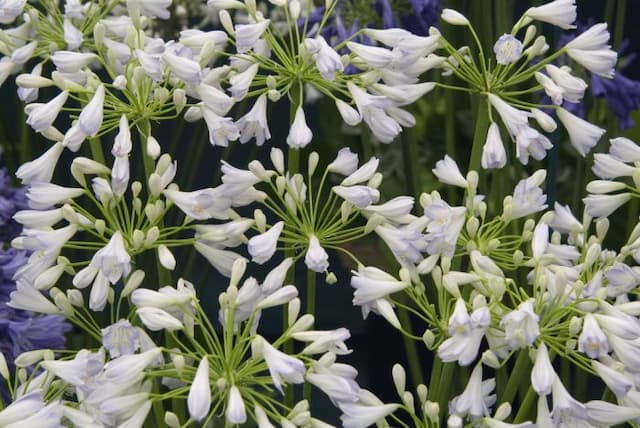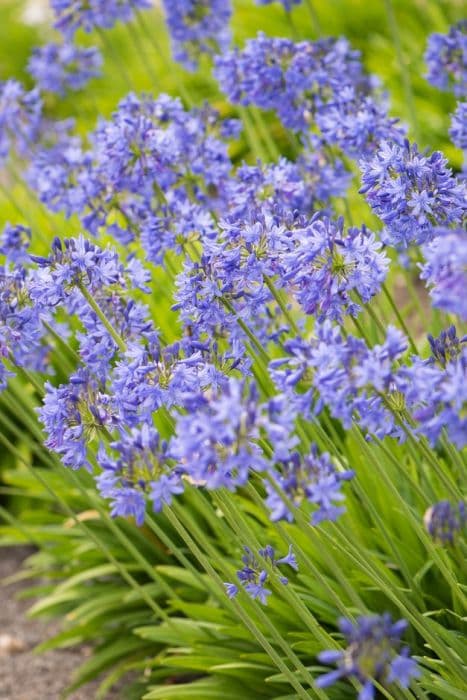Bell Agapanthus Agapanthus campanulatus 'Wendy'

ABOUT
The plant known as Agapanthus campanulatus 'Wendy', commonly referred to as the Bell Agapanthus, is appreciated for its distinctive floral arrangement and foliage. This variety of Bell Agapanthus features a lush clump of strap-shaped leaves that are graceful and arching, emanating a vibrant green color. These leaves create a dense and attractive base from which its striking flowers emerge. The most eye-catching feature of the Bell Agapanthus 'Wendy' is its bloom clusters, which comprise numerous small, bell-shaped flowers arranged in a rounded, globe-like cluster at the end of tall, erect stems that rise above the foliage. The flowers themselves are a lovely shade, usually found in shades of blue or purple, with each individual bloom exhibiting a subtle gradient and delicate petals. The overall appearance of the 'Wendy' Bell Agapanthus is that of an elegant and structured plant, with the spherical flower clusters providing a delightful contrast to the linear form of the leaves. The plant exudes a lush, exotic vibe, thanks to its trumpet-like flowers and the neat, fountain-like arrangement of its foliage.
About this plant
 Names
NamesFamily
Amaryllidaceae
Synonyms
Bell Agapanthus, African Blue Lily, Blue African Lily, African Lily, Love Flower
Common names
Agapanthus campanulatus 'Wendy'.
 Toxicity
ToxicityTo humans
The Lily of the Nile, when ingested by humans, can lead to symptoms of poisoning which may include nausea, vomiting, abdominal pain, and diarrhea. Particularly, saponins and glycosides found in the plant can cause these toxic effects. It's important to be cautious and avoid eating any part of the Lily of the Nile.
To pets
The Lily of the Nile poses a risk to pets if ingested. Dogs and cats may experience symptoms such as vomiting, diarrhea, abdominal pain, salivation, anorexia, or lethargy. The presence of saponins in the plant can cause these symptoms and potentially more severe health issues, so it is important to keep this plant out of reach of pets.
 Characteristics
CharacteristicsLife cycle
Perennials
Foliage type
Evergreen
Color of leaves
Green
Flower color
Blue
Height
2 feet 60 cm
Spread
2 feet 60 cm
Plant type
Bulb
Hardiness zones
8
Native area
South Africa
Benefits
 General Benefits
General Benefits- Attractive Flowers: Agapanthus campanulatus 'Wendy' produces beautiful blue to violet flowers that enhance the aesthetic appeal of gardens and landscapes.
- Drought Tolerance: Once established, it is relatively drought-resistant, making it suitable for xeriscaping or dry climate gardens.
- Low Maintenance: It requires minimal care once settled, ideal for gardeners seeking low-maintenance plants.
- Attracts Wildlife: The flowers attract pollinators such as bees, butterflies, and birds, promoting biodiversity.
- Long Blooming Period: It has a long flowering season, often from late spring to summer, providing color for an extended period.
- Border Planting: Its clumping habit makes it an excellent choice for borders, edges, or as a foundation plant in a garden design.
- Container Gardening: Suitable for pots and containers, it allows for versatile placement on patios, terraces, or balconies.
 Medical Properties
Medical PropertiesThis plant is not used for medical purposes.
 Air-purifying Qualities
Air-purifying QualitiesThis plant is not specifically known for air purifying qualities.
 Other Uses
Other Uses- Agapanthus, commonly known as Lily of the Nile, can be used as a natural dye. The flowers and leaves can provide color to fabrics and yarns.
- Ink production is another unexpected use; the pigments from the flowers can be extracted to make blue or purple inks for art purposes.
- Lily of the Nile can be used in flower arrangements, where their long-lasting blooms are prized for their structure and color.
- Due to its dense and clumping growth habit, it can be utilized for erosion control on slopes or banks as it can help stabilize soil with its root system.
- Agapanthus is often planted as a barrier plant, its thick roots and foliage forming a natural border that can discourage foot traffic through areas where it is unwanted.
- The tall, striking stalks of Lily of the Nile can be used in crafts, such as homemade wreaths or as part of mixed-media art projects when dried.
- Its root system can be useful in greywater treatment systems as it can tolerate and potentially filter out certain contaminants and soaps.
- For educational purposes, Lily of the Nile can be an excellent model in botany classes to study monocot flower structure and growth patterns.
- As a companion plant in gardens, it may help deter certain pests with its thick foliage while attracting pollinators like bees and butterflies.
- Agapanthus makes for an excellent photographic subject due to its vibrant colors and sculptural form, often used in botanical photography.
Interesting Facts
 Feng Shui
Feng ShuiThe African Lily is not used in Feng Shui practice.
 Zodiac Sign Compitability
Zodiac Sign CompitabilityThe African Lily is not used in astrology practice.
 Plant Symbolism
Plant Symbolism- Love Letters: The genus name "Agapanthus" is derived from Greek words 'agape' meaning love, and 'anthos' meaning flower. Hence, it is often seen as a symbol of love and can represent a message or a letter to a loved one.
- Enduring Love: The sturdy and resilient nature of the African Lily, as it is commonly known, reflects long-lasting and enduring affection.
- Beauty: With its striking blue to violet flowers, the African Lily is symbolically associated with beauty and a beautiful appearance.
- Home: Native to South Africa, the African Lily can symbolize home for those originating from there, as it is reminiscent of the region's flora.
 Water
WaterThe African Lily, commonly known as Agapanthus 'Wendy', should be watered deeply enough to saturate the root zone, and the frequency of watering should be such that the soil is allowed to become somewhat dry between waterings. During active growth in the spring and summer, watering every week with approximately 1.5 gallons per plant is usually sufficient. Reduce watering frequency to every two to three weeks during the fall and much less in winter, as the plant is dormant and requires less water.
 Light
LightAfrican Lily prefers full sun to partial shade. The best spot for this plant would be an area where it can get at least 6 hours of direct sunlight daily, while being protected from the harsh afternoon sun in very hot climates which can cause the foliage to scorch. A location with morning sun and afternoon shade would be ideal.
 Temperature
TemperatureAgapanthus 'Wendy' thrives in temperature conditions between 60°F and 80°F and can survive minimum temperatures down to about 50°F. They can tolerate brief periods of colder temperatures, but prolonged exposure to temperatures below 50°F will be detrimental. The African Lily ideally requires moderate temperatures and should be protected from extreme heat and frost.
 Pruning
PruningPrune the African Lily to remove spent flower stems and any damaged or yellowing leaves to encourage new growth. Pruning is typically done after flowering, usually in late summer or early fall. Cutting back the foliage every three to four years in early spring can rejuvenate the plant and stimulate better blooming.
 Cleaning
CleaningAs needed
 Soil
SoilThe best soil mix for African Lily 'Wendy' is well-draining and fertile, with a pH of 6.0 to 8.0. A blend of loamy soil, compost, and a handful of sand to improve drainage works well for optimal growth.
 Repotting
RepottingAfrican Lily 'Wendy' generally requires repotting every 2 to 3 years to refresh the soil and accommodate root growth. It's best done in the spring before the growing season begins.
 Humidity & Misting
Humidity & MistingAfrican Lily 'Wendy' thrives in moderate humidity levels. It does not require any special humidity conditions, making it suitable for typical indoor environments.
 Suitable locations
Suitable locationsIndoor
Provide bright indirect light, consistent moisture, and good air circulation.
Outdoor
Plant in partial sun, protect from strong winds, and ensure well-draining soil.
Hardiness zone
7-10 USDA
 Life cycle
Life cycleAgapanthus campanulatus 'Wendy', commonly known as Bell Agapanthus, begins its life cycle with seed germination, usually in the spring, where the seed breaks dormancy and begins to develop roots and shoots. Once the seedling becomes established, it enters a vegetative stage, during which the plant develops a clump of strap-like leaves and strengthens its root system. After reaching maturity, which can take several years, Bell Agapanthus enters the reproductive stage, producing tall flower stalks topped with clusters of bell-shaped flowers, typically in shades of blue, during the summer months. The flowers are then pollinated by insects, leading to the development of seed capsules filled with numerous seeds, which disperse when the capsules dry and split open. During the autumn and winter months, the above-ground parts of the plant may die back, particularly in colder climates, while the root system remains dormant until the following spring, when the plant begins a new growth cycle. This cycle of growth, flowering, seed production, and dormancy continues annually throughout the life of the plant.
 Propogation
PropogationPropogation time
Spring to Summer
Propogation: The most popular method of propagation for the Agapanthus campanulatus 'Wendy', commonly known as the African Lily 'Wendy', is through division. This process is ideally carried out in the spring before the growing season begins. Gardeners should carefully lift the clump from the ground with a spade, ensuring to maintain as much of the root system as possible. The clump is then gently teased apart into smaller sections, each with several growing points and a portion of the roots. These divisions can then be planted into well-draining soil where they will establish themselves and grow into new individual plants. It is important to keep the newly planted divisions well watered, providing about 1 inch (about 2.5 centimeters) of water per week until they show signs of new growth.









